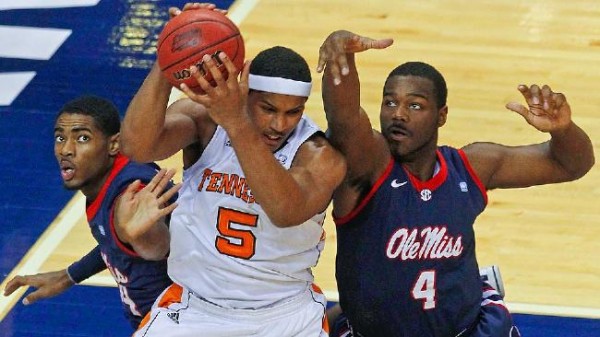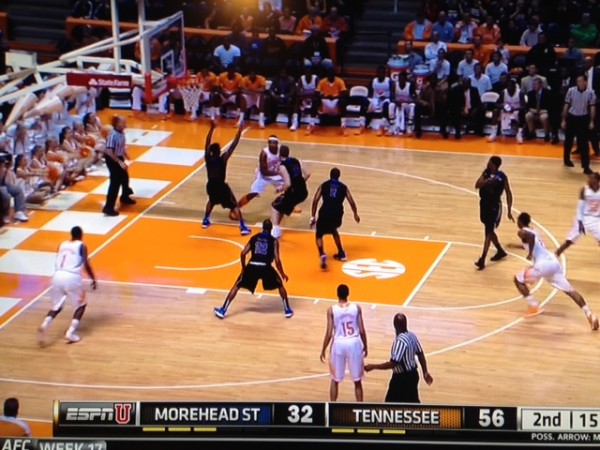Freeze Frame: The Rise and Fall of Jarnell Stokes
Posted by Brian Joyce on December 27th, 2013The Tennessee Volunteers were expected to compete near the top of the Southeastern Conference this season. Cuonzo Martin’s squad returned stars in Jarnell Stokes and Jordan McRae, regained forward Jeronne Maymon from injury, and added veteran guard and Memphis transfer Antonio Barton to run the point. On paper everything was in order for the Vols to become a real contender, but something hasn’t clicked as the team is currently 7-4 with losses to Xavier, UTEP, Wichita State and North Carolina State. Martin is struggling to find consistency at the point guard position; he occasionally has difficulty reining in McRae on a bad shooting night; and he hasn’t been able to get Stokes to the next level in his performance.
While Tennessee has several issues, none are more important for Martin to figure out then Stokes’ ongoing struggles. The junior forward was expected to take a huge leap forward this season, but that hasn’t yet happened. And as Stokes goes, so goes Tennessee. Stokes correlation with the team’s overall results aren’t unexpected, but the strength of the relationship is uncanny. In Tennessee’s four losses this season, the junior has struggled with a significant decline in his offensive rating, usage, points per game, rebounds per game, and effective field goal percentage.
The biggest key to Stokes’ success is getting him the ball in a position to be successful. In 2012-13, Stokes took over 70 percent of his shots at the rim (according to hoop-math.com), connecting on 64.6 percent of those attempts. While he has maintained roughly that same field goal percentages this season, the forward has taken almost 10 percent fewer shots at the rim in favor of a lower efficiency mid-range game. Stokes needs to find a level of consistency by taking the shots he is most comfortable making.
The opportunities for offensive improvement aren’t found solely in limiting Stokes’ mid-range game. After analyzing some of the game film, it is easy to see that some small adjustments near the rim could go a long way in improving Stokes’ efficiency. In the first play below, Stokes rolls to the basket in a pick and roll situation on the perimeter. He attacks the defender aggressively by rolling straight to the basket and putting the shot up quickly. There is nothing fancy about Stokes’ move, but he is aggressive in his drive to the basket. This is the kind of offensive possession where Stokes is most effective.
Stokes’ aggressiveness pays off in the first play, but he hesitates slightly in a play later in the game. He is the screener in another pick and roll from the perimeter, but he fails to get off a shot against a smaller defender, giving him time to regain his defensive position between Stokes and the basket. This lack of aggression in attacking the basket forces Stokes into a failed hook shot over a taller defender.
In the below image, you can see that Stokes had a clear advantage over a smaller defender had he taken the ball strong to the basket.
In yet another play later in the game, Stokes runs across the lane over a screen for a narrow opening in the low post. He should have made a quick offensive move, but instead hesitates again, giving the defense an opportunity to double-team him. Stokes then compounds his mistake by forcing up a shot rather than passing out of it.
Stokes has a good repertoire of offensive moves, but some of his hesitation and lack of aggressiveness in the post can lead to opportunities for the defense to recover, giving the opposition the advantage. If Stokes can limit contested shots in the mid-range and become more aggressive in getting shots off in the low post, he can significantly improve his offensive efficiency. No other player on the Tennessee roster has a stronger correlation with his team’s success or failure than the 6’7″ junior. With a corresponding jump in offensive performance, Stokes should be able to drastically improve the Volunteers’ results in the win-loss column going into SEC play. Of course, there’s no better time than the present to raise tempered expectations and pull out of a disappointing slump for both Tennessee and Stokes.















































